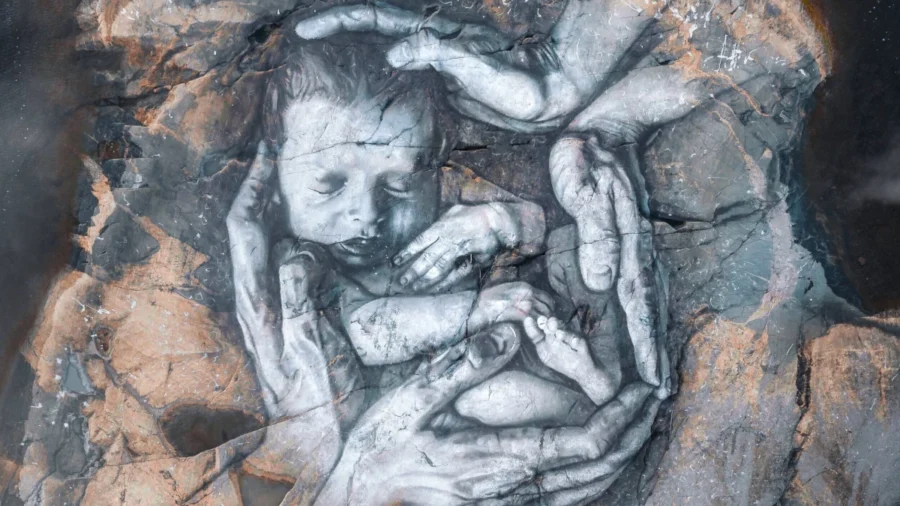Human civilization has always sought to leave traces that withstand the test of time – from the pyramids of Egypt to the digital archives of our present. Yet, in this collective yearning for durability, an artist emerges, David Popa, whose creations consciously celebrate transience. His monumental earth frescoes, existing only for moments before being reclaimed by the elements, challenge our conventional notions of art, heritage, and permanence. David Popa’s work is not merely an aesthetic manifestation but a profound reflection on our relationship with nature, the fleetingness of existence, and the urgent need to respect our planet. In an era where environmental consciousness and the search for authenticity shape central societal discourses, Popa’s art offers a unique approach to these questions by using the Earth itself as both canvas and medium.
The Roots of Transience: David Popa’s Artistic Development and Influences
David Popa, an artist born and raised in New York City, found his early artistic grounding through his father, Albert Popa, an influential graffiti artist of the 1980s in New York. This early mentorship encouraged him to experiment with the free nature of “street art” and muralism, transferring these forms of expression to still lifes and portraits. During his studies, these interests merged into large-scale mural portraits, and engaging with street art taught Popa valuable lessons about the physicality of this practice and the temporary nature of his creations. These experiences in the urban art world, where works were often quickly painted over or removed, laid the groundwork for his later acceptance and celebration of impermanence.
At the age of 21, David Popa took a decisive step in his artistic career: he moved to Finland, where he lives to this day. Surrounded by abundant Scandinavian nature, his focus shifted from urban walls to organic surfaces. This transition from graffiti and urban murals to land art in nature is far more than a mere change of medium or location. It is a profound philosophical evolution. While graffiti is inherently transient – it is painted over, removed, or weathered – and this ephemerality in the urban space prepared Popa for transience in nature, the move to the wilderness marks a conscious turn towards the fundamental forces of the planet. The city, though dynamic, remains a human-controlled space. Nature, however, is uncontrollable and infinite. This decision points to a search for a deeper, more universal form of transience, determined not by human interventions but by the elemental processes of the Earth. It is a conscious submission to the power of nature and the acceptance of its processes as an integral part of the artwork, representing a departure from human dominance in the urban space.
From 2017-18, David Popa began creating his first “ephemeral earth frescoes” on stone and other raw, wild surfaces. Inspired by natural minerals used in prehistoric cave drawings and geoglyphs, Popa refers to himself as a “paleo-painter” – a continuation of this ancient tradition. He uses the same raw materials as the earliest cave painters 40,000 years ago, including charcoal, earth, and ground shell pigments. David Popa’s self-designation as a “paleo-painter” is more than just a historical reference; it establishes a profound connection between the earliest human art and contemporary environmental art. By choosing the same materials and a similar approach as prehistoric artists, Popa highlights a universal human necessity for artistic expression that endures across cultures and epochs. This implies that art is an intrinsic part of human nature, a primary form of communication and reflection on our existence and our environment. Simultaneously, it serves as a commentary on the permanence of the Earth in contrast to the fleetingness of human life. The cave paintings have survived millennia, while Popa’s works disappear in weeks. This emphasizes the cyclical nature of creation and decay and human humility in the face of time and the forces of nature. It is a reminder that we, like our prehistoric ancestors, leave only temporary traces on a much older and more enduring planet.
The Earth’s Signature: Techniques, Materials, and the Dialogue with Nature
David Popa’s artistic signature is inextricably linked to his choice of canvas: the landscapes of the Finnish archipelagos, as well as Norway, Greece, France, and the USA. His large-scale works, often portraits or figurative representations, are mostly painted on islands and islets in the Nordic region. He transforms natural landscapes into visually stunning artworks that are both captivating and awe-inspiring.
Popa has perfected a technique that is both adhesive and respectful of the environment in which he works. He works exclusively with earth pigments such as charcoal, chalk, and water. He deliberately avoids binders, making his art truly ephemeral and sustainable, leaving no trace. The materials used often reflect the location, and he sources his palette directly from the surroundings to create a deep connection to the respective places.
David Popa’s creative process is long and meticulous – from scouting locations to creating mock-ups and realizing the project. He describes his practice as an act of “unearthing,” where art emerges from the ground. Yet, despite meticulous planning, his process is a “co-creation with nature” and an “emotional experience.” His works are subject to weather conditions such as light or water exposure, meaning his creations are always short-lived; they fade after a few minutes to a few months. Unexpected events such as bird droppings appearing as dynamic brushstrokes, or changing tides revealing new rock layers, are part of this dynamic dialogue with nature. While many artists strive for control over their medium and environment, David Popa consciously integrates the unpredictability of nature into his creative process. The dependence on weather conditions such as rain, frost, and wind, and the physical challenges such as breaking ice floes, impassable terrain, or even illness, are not understood as obstacles but as co-authors of the work. This leads to a humility of the artist towards forces greater than himself, and gives each work a unique, unplanned dimension. Art becomes a living, breathing dialogue with the Earth, where the end product is often a surprise, even for the artist. This underscores the authenticity and deep respect for nature that permeate Popa’s work.
Since the physical works are ephemeral, David Popa documents his pieces through collaboration with the elements – sea, wind, and ice – and uses drone technology, videography, and photography to capture his nature-blending paintings from above. The remaining work takes the form of films that tell stories about the mystery of life and our urgent need to care for our planet. This documentation is not merely proof, but an integral part of the artwork itself, making it accessible to a wider audience and extending its impact beyond its physical existence. In an era where the physical presence of artworks is often considered the ultimate value, David Popa shifts the paradigm. His physical works are, by definition, short-lived; their actual “exhibition” and resonance occur through digital documentation. This makes photography, videography, and even NFTs not mere recordings, but the primary art objects that can exist permanently and be disseminated. This is a profound commentary on the role of technology in art and the nature of perception in the 21st century. It raises the question of whether art needs to be physically present to be “real,” and emphasizes the power of digital reproduction to preserve and universalize a fleeting experience.
Mirror of Existence: Central Themes and Philosophical Dimensions
Transience is the central theme in David Popa’s work. His works are conceived as a “poignant reminder of the transience of our existence and the mysteries of the world we live in.” He emphasizes the inevitability of change as time passes, seasons change, and the environment warms. The natural dissolution of his artworks is not just a feature, but the ultimate statement about the cycles of creation and decay. Instead of mourning transience as a loss, David Popa sees it as a liberating force. The knowledge that his works will disappear compels both him as an artist and the viewer to be present and to appreciate the current moment. This contrasts with the traditional art world, which is focused on conservation and eternity. Popa’s approach suggests that the true value of art lies not in its material durability, but in the experience it evokes and the reflection it stimulates. It is an invitation to recognize the beauty in letting go and to appreciate the “everyday miracles” of fleeting existence.
David Popa’s art illuminates our connection to nature and ignites our sense of spirituality. He portrays human life immersed in nature. His works ask fundamental questions: “Where do we come from and what are we doing on Earth?”. He sees his work as an expression of life and questions our place and role in our ecosystem. The choice of materials, which come directly from the earth, and the interaction with the elements reinforce this spiritual and ecological dimension. David Popa’s art goes beyond mere aesthetics and becomes a vehicle for spiritual and ecological insight. By embedding human forms in nature and then allowing them to be reclaimed by it, he symbolizes the inseparable connection and ultimate unity of humans with the Earth. The questions of origin and destiny are not only philosophical but also an implicit call for ecological responsibility. If our existence is as fleeting as his paintings, and we come from the Earth and return to it, then the care of this birthplace and grave is of utmost importance. Art thus becomes a silent but emphatic manifesto for mindfulness and stewardship towards our planet.
Popa’s work attempts to enter the realm of anthropology, as it relates to human origin, nature, and destiny. The use of materials similar to the earliest cave paintings underscores this search for the roots of human existence and artistic expression.
Art in Discourse: Reception, Challenges, and Cultural Significance
David Popa’s large-scale land works have gained international recognition and have been featured by media outlets such as BBC, CNN, and Colossal. Public perception is overwhelmingly positive, often described as “breathtakingly beautiful” and “deeply emotional,” with viewers feeling overwhelmed by the artist’s “insight and ability.” The universality of themes such as transience, transcendence, and the beauty of nature appeals to a global audience.
The creation of David Popa’s art is a physically demanding endeavor, often taking place in remote, harsh, and unpredictable environments. The dependence on the whims of Mother Nature – changing tides, breaking ice floes, sudden storms or rain washing away pigments – poses immense challenges and can ruin the artist’s work. Personal challenges, such as painting while having the flu, are also part of the process. The extreme conditions under which David Popa works are not just logistical hurdles, but shape the artwork itself and its philosophical statement. The physical exertion, the confrontation with danger, and the need to act quickly and intuitively to capture fleeting moments, make the creative process a kind of performance or spiritual pilgrimage. This gives the final product, be it a photo or film, an additional layer of authenticity and respect for overcoming adversity. Art becomes a testament to human endurance and the dialogue with an overwhelming nature, which enhances the emotional depth and resonance with the audience.
David Popa’s work is deeply rooted in the principles of sustainability and environmental consciousness. He challenges conventional notions of art conservation and appreciation by suggesting that the value of art lies in its ability to create transient interventions that influence our perception of the environment. His art aims to inspire a sense of responsibility and protection towards the Earth.
David Popa is a prominent contemporary Land Art artist, a movement that uses natural landscapes to create site-specific structures and art forms. He is often mentioned in the same breath as pioneers like Andy Goldsworthy. Unlike some early Land Art artists who removed their works from traditional art spaces to emphasize the commodification of art, Popa’s background in street art is a testament to a more primal connection to nature. His work is a powerful expression of life and questions our role in the ecosystem.
Monumental Traces in the Flow of Time: Selected Projects and Their Resonance
The “Fractured” series is a profound project created on various ice floes in Southern Finland, and directly responds to the ongoing conflict in Ukraine, highlighting the “fractured state of the world.” Popa created portraits on the fragile ice floes, which unexpectedly broke, leading the artist to question whether continuing the work was even worthwhile. From the ground perspective, no silver lining could be discerned within the chaos, yet from above, the fragments revealed a harmony and beauty imperceptible from any other perspective. The work invites the viewer not to despair and chaos, but rather to ask where we must look to mend the broken fragments of our reality and perhaps how the fragments can be used to create an entirely new mosaic. The “Fractured” series is an outstanding example of how David Popa integrates global, socio-political themes into his nature art. The breaking ice floes become a direct metaphor for the fragmentation of the world, especially in the context of the Ukraine conflict. The crucial point is the change of perspective: what appears as chaotic destruction from the ground, reveals an unexpected harmony from a bird’s-eye view (drone). This is a profound message that goes beyond art: it suggests that we often need a higher, more comprehensive perspective to find solutions to seemingly intractable problems. Art here becomes a medium of hope and a call for reconstruction, not only of physical but also of societal and psychological “fragments.”
The “Born of Nature” project was created in collaboration with Finnish photographer and composer Juuso Hämäläinen. The concept organically evolved into a newborn sleeping in the “womb of the Earth,” inviting the viewer to marvel at life and question the mysteries of our birth and our swift departure from this world. For this project, biodegradable, natural pigments, mixed only with water, were used to create massive murals that naturally decompose. The collaboration included a short film with an original soundtrack that integrated natural sounds from the environment.
For the second season of the nature documentary “Prehistoric Planet” with Apple TV+, David Popa created three large-scale portraits of prehistoric creatures directly on natural landscapes: a T-Rex in Utah, a Hatzegopteryx on an island in Finland, and a Triceratops on the Jurassic Coast in England. These works, which took up to 15 hours to complete, were created with organic materials such as charcoal, chalk, and earth pigments, utilizing the natural textures of the terrain. Their immense size made them fully visible only from the air, before being washed away by the weather.
The AlUla “Heritage Monument,” also known as “Hands of Sands,” is a unique, monumental work in the landscape of AlUla, Saudi Arabia, taking the form of two protective hands. It was constructed around the iconic Tomb of Lihyan, Son of Kuza (UNESCO World Heritage Site). Made exclusively from natural elements such as yellow earth from Europe and red earth from the Middle East, the work was one of Popa’s largest to date and was designed to decompose within a few weeks. This work emphasized the urgent need for collective action to protect cultural heritage and symbolizes the ability to nurture and protect.
The “Fire and Ice” project is a journey into extremes, an ephemeral series created on a volcanic field and a glacial expanse in the heart of Iceland. The portraits were painted directly onto the Earth, with the raw forces of nature shaping the final form. “Born of Fire” (on a lava field) addresses rebirth through hardship, while “Surrender” (on a glacier) explores fragility, reverence, and spiritual stillness. Each work was created within a week, vulnerable to wind, sun, and melt, and then disappeared with the next rain. The project is about transience, transformation, and returning to the origin of art: earth, body, and spirit.
David Popa’s art is a profound meditation on transience, inviting us in an increasingly fast-paced and digitized world to pause and recognize the beauty in the fleeting. His monumental earth frescoes, which surrender to the unstoppable flow of nature, are more than just aesthetic gestures; they are a plea for mindfulness, for a deeper connection to our planet, and for the acceptance of the eternal cycle of becoming and passing away. By elevating the Earth itself to a canvas and welcoming its elements as co-artists, David Popa reminds us that we are inextricably linked to nature and that true beauty often lies in the moments we cannot hold on to. His works fade, yet the questions they raise and the spiritual resonance they leave behind echo long after, urging us to rethink our role in the great ecosystem and to honor the precious, fleeting existence on this planet.









